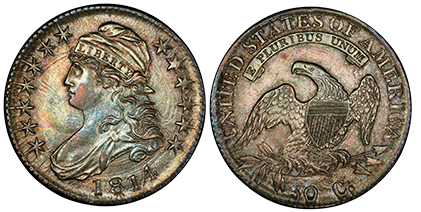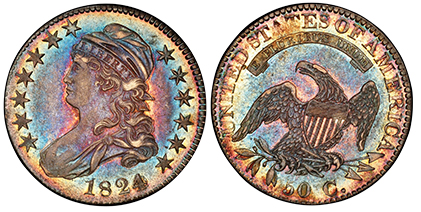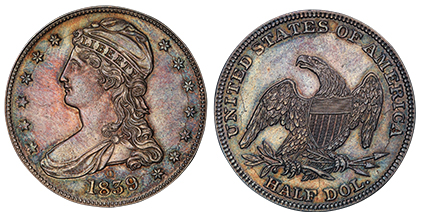
By David Manevitz and Barry Sunshine
The Capped Bust half dollar, minted between 1807 and 1839, is one of the most popular and widely collected coin series from the early 19th century. First designed by Johann Matthaus Reich, it followed the short-lived Draped Bust half dollars, which were made from 1796 to 1807. Reich is also known for designing the Capped Bust half dime, dime, and quarter. The Capped Bust half dollar produced from 1807 to 1836 is also known as the Lettered Edge Capped Bust half dollar, with the edge lettering reading “FIFTY CENTS OR HALF A DOLLAR.” This lettered edge was eliminated in 1836 when Christian Gobrecht designed the Reeded Edge Capped Bust half dollar, which was minted from 1836 to 1839.
The Capped Bust half dollars were the most popular coins of the time. However, they did not actually widely circulate in commerce. As a result, many Capped Bust half dollars can still be frequently found in About Uncirculated or Mint State condition due in part to the fact that they were largely stored in bank vaults and used as a source of large bank-to-bank transactions. In addition, state banks at the time were making their own paper currency, which had to be backed by another source of money. In order to meet this demand, banks used the Capped Bust half dollars stored in their vaults, which in turn spared these coins from being melted or heavily circulated over the years.

The lettered edge Capped Bust half dollars were minted each year except in 1816, when a fire broke out in the U.S. Mint in January of that year. This caused production to cease until it resumed again in 1817. The mintage of the Capped Bust half dollar ranged from just 47,150 in 1815 to more than 6.5 million in 1836. Capped Bust half dollars were struck with the use of a manpowered screw press typically operated by five persons, whereby each working die was individually made, with the stars, letters, and numbers all punched by hand. The obverse and reverse working die would come together as the Mint workers each turned the metal screw press levers after a softened blank metal planchet was inserted into the coining chamber. One by one, Capped Bust half dollars were made and were able to be produced in very large quantities using this technique. During the period of 1807 to 1836, the Mint produced more than 82 million Capped Bust half dollars. While this may seem like a lot, it does not compare to the billions of Lincoln cents that are minted each year today. Very interesting is the fact that almost half of all the Capped Bust half dollars produced were made from 1830 to 1836. This, in turn, has led to the earlier dates, 1807 to the mid 1820s, being sometimes tougher to locate in better condition than the later years.
One of the main attractions of collecting Capped Bust half dollars stems from the numerous varieties this series has to offer. Throughout the years, the Capped Bust half dollars were minted in subtle design type changes to Miss Liberty’s face, bust, and obverse hair curls, as well as the position of the eagle on the reverse. However, this series is also known for having many other interesting varieties. These include engraving errors such as the 50/20 variety in 1807, the 50C over UNI in 1813, and the E/A in STATES in 1814, just to name a few, as well as numerous overdates, including the key 1815/2; the highly unusual 1824/2/0, also known as the 1824 Over Various Dates; and the most famous of all half dollar varieties, the 1817/4, with only 11 known to exist today. In 1809, the Mint even experimented with the edges by placing either an XXX or III between some of the letters.
Along with these engraving errors and overdates came subtle changes over the years to the size, shape, and placement of the stars, letters, and numbers on the coins, thus adding to the allure and increased varieties sought by collectors of this series. Some of these additional varieties include the 1807 Small and Large stars, the 1812/1 Small and Large 8, the 1827 Square Base and Curl Base 2, and the 1832 Small and Large Letters.

Another interesting and collectible feature to these coins arose when the dies themselves started to break down and crack. This occurred more frequently in the early years from 1807 to around 1813 due to the Mint’s lack of experience with forging the steel needed to make the working dies. As a result of the dies falling apart, thin areas of raised metal would be imparted on the planchets, giving rise to coins with die cracks, some more impressive than others. One such variety includes the famous and scarce Bearded Goddess of 1807, whereby a die crack formed from the chin to the chest of Miss Liberty. Even well worn examples of this highly coveted variety in the XF range can bring five figures at auction.
The Capped Bust half dollar series can be collected in several ways. Many collectors start out by putting together a date set, while others get a little more involved and choose to assemble a Red Book (A Guidebook of United States Coins, by R.S. Yeoman) set that includes several varieties for many of the individual dates. Finally, there are people who choose to study the minutia of the various obverse and reverse dies used to make these coins and collect them by die marriage. Currently, there are 450 different die marriages known, with each assigned a different Overton number, named after the researcher and author Al Overton (1906-1972).
Overton first published his definitive guide to attributing Capped Bust half dollars, entitled Early Half Dollar Die Varieties 1796-1836, in 1967. This book and the several new editions since it was first released are widely used today by many to identify the different die marriages. Those who collect by Overton number are sometimes known as “Nuts,” partly because they have to be crazy to want to collect all 450 die marriages but also because many of them belong to a group of specialized Capped Bust half dollar collectors known as the Bust Half Nut Club. For advanced collectors such as these, putting together a complete Overton collection is a lifelong endeavor and a dream come true. Thus far, just a handful of people have been able to assemble a complete Overton Set with all 450 die marriages.

Whether you are a beginner or an advanced collector, and whether you collect them by date, Red Book variety, or by Overton number, the relatively low cost and availability of the Capped Bust half dollar makes this series an ideal one for study and offers numerous opportunities for those interested in learning about and collecting coins from the early 19th century.













